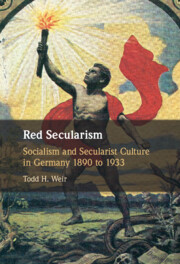Book contents
- Red Secularism
- Red Secularism
- Copyright page
- Contents
- Figures
- Tables
- Preface
- Abbreviations
- 1 Introducing Socialism and Secularism as Two Cultures
- 2 Secularist Culture in an Industrializing City
- 3 Prometheans
- 4 The Sociology and Psychology of Secularist Intellectuals
- 5 Workers and Worldview
- 6 The Politics of Secularism 1905–1914
- 7 Secularists in War and Revolution 1914–1922
- 8 Monism in the Weimar Workers’ Culture Movement
- 9 Culture War at the End of the Weimar Republic
- Epilogue
- Appendixes
- Archives Used
- Index
Epilogue
Published online by Cambridge University Press: 30 November 2023
- Red Secularism
- Red Secularism
- Copyright page
- Contents
- Figures
- Tables
- Preface
- Abbreviations
- 1 Introducing Socialism and Secularism as Two Cultures
- 2 Secularist Culture in an Industrializing City
- 3 Prometheans
- 4 The Sociology and Psychology of Secularist Intellectuals
- 5 Workers and Worldview
- 6 The Politics of Secularism 1905–1914
- 7 Secularists in War and Revolution 1914–1922
- 8 Monism in the Weimar Workers’ Culture Movement
- 9 Culture War at the End of the Weimar Republic
- Epilogue
- Appendixes
- Archives Used
- Index
Summary
The Epilogue examines the failure of red secularism to reassert itself after 1945 due to the political climate in East and West Germany. It examines the further decline of Freethought as a consequence of lessening of confessional tensions in German society and the secularization and de-churching of German society in the 1960s.
- Type
- Chapter
- Information
- Red SecularismSocialism and Secularist Culture in Germany 1890 to 1933, pp. 323 - 335Publisher: Cambridge University PressPrint publication year: 2023

